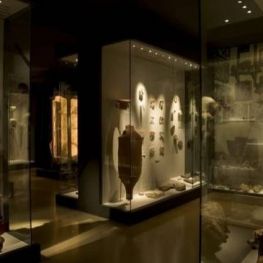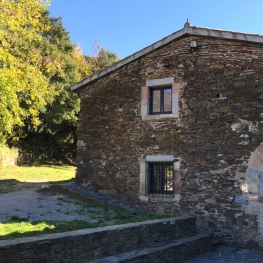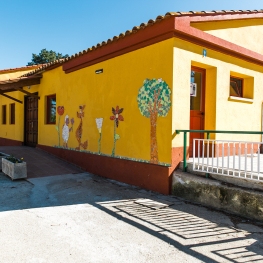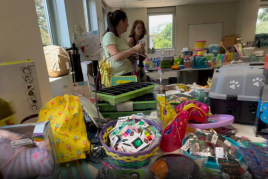Audiosigned route in Sant Celoni

It is the first audiosignat itinerary created by the municipality of Sant Celoni. The tour includes 12 points of historical and cultural interest, marked on the ground with a small foot that contains a brief description, an indication to access the next point, and a QR code that allows downloading for mobile devices a complete video description of the point of interest, with audio (for people with visual impairment) and sign language (for people with hearing disabilities).
All the texts, audios and sign language, in all the supports of the itinerary (feet, leaflets or mobile application) are available in four languages: Catalan, Spanish, English and French. The complete itinerary lasts approximately 2 hours.
Welcome to Sant Celoni, a city full of history that you will know about following this itinerary. Strolling through its streets you can go back in time and discover the origins and evolution of this town that since ancient times was an important meeting point for merchants and travelers who went to Barcelona or Girona on the royal road that passed through the city.
1. Old Hospital
The route begins in the neighborhood of Vilanova, the last extension of the fortification that extended the Calle Mayor to the junction with the current street Germà Emilià, located on your left. Until the nineteenth century, was the portal that closed the town and was called Can Bonavida portal.
The Vilanova was a typical neighborhood of the small agriculture and Barcelonian art and some of its houses conserve today the original portals. Known as the Old Hospital or the poor and sick of San Antonio Abad, it was a charitable and health institution of medieval origin. The center was formed by the hospital and the chapel.
The building, distributed in ground floor and two floors, surrounded the central patio. On the ground floor there were several chambers and the sacristy. Behind the chapel was the refectory, the kitchen and the pantry. On the first floor there were rooms for the sick, while the second floor was the community of nuns.
At the entrance of the building you can see a large portal with a round arch, with a relief on the upper part that represents the crucifixion. The chapel was rebuilt in 1752 and retains a popular baroque altarpiece.
Currently, part of the building houses the Tourism Office, which in addition to providing information on the resources of the municipality, is an information point of the Montseny Natural Park and the Montnegre and Corredor Park.
We will continue the journey down the main street towards the center.
2. Portal of the hours
Between the streets of San Martín and Mayor, where the portal was located and the Torre de las Horas, you will find the second extension of the wall. Above the portal there was a chapel where Santa Tecla was worshiped and at the top were the bells of the public clock, for which reason it was known by that name.
On the lintel of the doors you can see some inscriptions from this era that refer to some date, the name of the owners or the symbol of the different trades. You can also see the decorations of some original windows of the sixteenth century, which stand out for decorative characteristic of late Gothic style.
Now follow down the Calle Mayor until you reach the Plaza de la Iglesia.
3. Parish Church of Sant Martí
You in front of the Parish Church of Sant Martí, a baroque building that is undoubtedly the most emblematic element of Sant Celoni's architectural heritage.
The sgraffiti of the façade, the most important of the Catalan Baroque both for the large surface they occupy and for the good state of conservation, were completed in 1762. They show allegorical figures of virtues (faith, hope, charity and justice), archangels, saints, musical angels... that are arranged on the facade forming a monumental altarpiece that was restored in 2003.
 Another highlight of the cover is the sculpture of Sant Martí, by the sculptor Lluís Montané, made in 1953. In the interior, you can see another image of Sant Martí, by the same author, the canopy with a dome, designed by the architect Francesc Folguera and the murals of the apse of the painter Isidre Roig de Casas, with representations of various scenes of the saint's life. It is a building with a rectangular floor plan and an octagonal apse with buttresses on the outside, between which there are five chapels on each side
Another highlight of the cover is the sculpture of Sant Martí, by the sculptor Lluís Montané, made in 1953. In the interior, you can see another image of Sant Martí, by the same author, the canopy with a dome, designed by the architect Francesc Folguera and the murals of the apse of the painter Isidre Roig de Casas, with representations of various scenes of the saint's life. It is a building with a rectangular floor plan and an octagonal apse with buttresses on the outside, between which there are five chapels on each side
4. Mayor Street
The town was growing along the main street, following the layout of the medieval royal road. Along with the Plaza de la Villa, the main street is the commercial center of the town and has shops and establishments -some of centenarian tradition- that serve the natural region of Baix Montseny.
Some houses stand out between the sixteenth and eighteenth centuries.
In number 93 is the house of the men of Vilardell, descendants of the legendary knight, Soler de Vilardell. Legend has it that a fierce dragon had frightened the population of Sant Celoni until the knight killed him with his sword of virtue. The falls where the beast was hidden can be visited and is part of an itinerary whose information can be requested from the Tourist Office. Of this house they emphasize the wrought iron balcony and the decorated tiles. At number 136 we find Can Maties with two ogee windows worked in granite.
Continue down the Calle Mayor until you reach Plaza de la Villa.
5. Plaza de la Villa
It is located in the Plaza de la Villa, the nerve center of Sant Celoni that welcomes markets, parties and events of all kinds. Due to its importance, several buildings of historical and architectural interest were built here, among which Casa de la Villa stands out.
 To the right of the town hall we find Can Ramis, a house of the XVII and XVIII centuries that takes the name of the owner family. It was reformed in 1950 maintaining a good part of the original elements, such as the portal with the family coat of arms. Other elements that are currently preserved, such as the gallery of reduced arches on the second floor, were added recovered from a house in Barcelona.
To the right of the town hall we find Can Ramis, a house of the XVII and XVIII centuries that takes the name of the owner family. It was reformed in 1950 maintaining a good part of the original elements, such as the portal with the family coat of arms. Other elements that are currently preserved, such as the gallery of reduced arches on the second floor, were added recovered from a house in Barcelona.
Finally, it is worth highlighting the sculpture by Carles Colomo that was dedicated to the Ball de Gitanes on the occasion of the 20th dance after the recovery of this popular tradition. The Ball de Gitanes, documented in 1767, is a typical Vallès dance and it should be noted that Sant Celoni has music, costumes and a dance of its own. It is danced every Sunday of Carnival in this same square.
Continue the tour down the Calle Mayor until you reach the Plaza del Ganado.
6. Barrio de la Fuerza
A few meters further on, on the stretch of the main street that from this square to that of Josep Alfaras, you will find the oldest part of the town, known as the Barrio de la Fuerza, the medieval walled town, which was formed to protect the group of houses that surrounded the chapel of Sant Celdoni, at the foot of the royal road.
The Force had two portals, the Mayor or Barcelona, which overlooked this square and the remains are clearly seen on the corner of Can never close with the main street, and that of the Sants Metges, in the direction of Girona, where there was a chapel to venerate these saints.
From this point, you can go to see the renowned restaurant Can Fabes, in the street of San Juan, founded by the deceased chef Santi Santamaria in 1981 and which was the first Catalan restaurant awarded with 3 stars of the Michelin guide. The restaurant closed in 2013.
To continue with the tour, advance through the Calle Mayor until you reach the Plaza Josep Alfaras.
7. Can Casquet Tower
 Of the five towers that, at least, originally had the Force as a whole, only two remain and the angle of a third. The tower that contemplates now and that was inside a private house, is the call of Cal Aymar or of Can Casquet. The battlements that crown it are added later.
Of the five towers that, at least, originally had the Force as a whole, only two remain and the angle of a third. The tower that contemplates now and that was inside a private house, is the call of Cal Aymar or of Can Casquet. The battlements that crown it are added later.
To the right of the tower, you will find the rue de les Valls, which reminds you of the valley or moat that surrounded the wall and that filled with water when there was danger to hinder access to the site.
Following this street you will reach the Tower of the Force, restored in 2009.
8. Force Torus
This architectural element of the medieval era was restored in 2009 and for this they had to demolish two houses that had left hidden.
It is a cylindrical tower with a taloned base. Its lower part shows the level of the soil in medieval times that was rising over the years when the area was used to make gardens and other buildings.
From inside we can see that there is no access from the wall inside the building so it is known that it was accessed from the skylight at the top.
Once the visit is finished, go back and resume the Calle Mayor towards the Rafael Ferrer square.
9. Sant Ponç
It is in the Plaza Rafael Ferrer, where the chapel of Sant Ponç is located, the only vestige of the old hospital of leprosy of Sant Nicolàs that occupied part of the current square, located outside the walls to avoid contagion to the villagers. It is a good example of late Romanesque popular style, late twelfth or thirteenth century, restored several times and consisting of a nave and semicircular apse.
To continue with the tour you have to go to the street of Comte Borrell, to the left of the chapel and down to the Paseo del Pertegàs.
Once there, take the walk to the left until you reach the Rectoria Vella.
10. Paseo del Pertegàs
 The Paseo del Pertegàs is one of the most pleasant and peaceful places we find in Sant Celoni. With almost a kilometer and a half, it is a road for pedestrians and cyclists that runs parallel to the stream of Pertegàs, a tributary of the Tordera, which allows access to several long-distance roads and other local routes such as Maribaus. The stream is a connector between the urban core and the immediate natural environment, of capital importance for the municipality, since its geographical location has had a close relationship with the mountain.
The Paseo del Pertegàs is one of the most pleasant and peaceful places we find in Sant Celoni. With almost a kilometer and a half, it is a road for pedestrians and cyclists that runs parallel to the stream of Pertegàs, a tributary of the Tordera, which allows access to several long-distance roads and other local routes such as Maribaus. The stream is a connector between the urban core and the immediate natural environment, of capital importance for the municipality, since its geographical location has had a close relationship with the mountain.
Now continue along the promenade until you reach the Parque de la Rectoria Vella and go up in the garden by the staircase to the left of the promenade.
11. Rectory Park
This beautiful garden surrounds the buildings of the original core of the city (Sant Martí de Pertegàs and La Rectoria Vella), making the place one of the most pleasant places in Sant Celoni. The garden began to trace the year 1920, when the Rectoria Vella was a summer center and was remodeled in 2000.
 The church that you see to the right, is the primitive parish of the town and is documented of century XI. Of Romanesque origin, it expanded considerably in the fourteenth century to adapt to the needs of population growth, adding two aisles and aisles.
The church that you see to the right, is the primitive parish of the town and is documented of century XI. Of Romanesque origin, it expanded considerably in the fourteenth century to adapt to the needs of population growth, adding two aisles and aisles.
Currently, you will find, in the rooms of the ground floor, temporary exhibitions of painting, sculpture, photography...
To continue with the tour, exit through the main entrance of the garden and take the Paseo de la Rectoria Vella on the left until you reach the Municipal Library.
12. The slaughterhouse
 In 1926, the municipal architect Josep Domènech Mansana designed this building, somewhat separated from the center, to house the slaughterhouse of the city. The construction follows the form of a farmhouse with a basilica floor plan, with the central nave higher to facilitate the lighting of the space. In 1999 it was rehabilitated and converted into a municipal library with the annexation of a lateral body that can be seen to the right of the building.
In 1926, the municipal architect Josep Domènech Mansana designed this building, somewhat separated from the center, to house the slaughterhouse of the city. The construction follows the form of a farmhouse with a basilica floor plan, with the central nave higher to facilitate the lighting of the space. In 1999 it was rehabilitated and converted into a municipal library with the annexation of a lateral body that can be seen to the right of the building.
Here ends your audiosigned visit. If you go up one of the streets in front of the library, in a few minutes you will reach the center of the city where you will find a wide range of restaurants that offer a varied and quality cuisine, as well as several establishments of centuries-old tradition with artisan products and own the villa.
You can access all videos and documentation of the audiosigned route of Sant Celoni to the municipal website.
Source: City Council of Sant Celoni
What to do
Bosc Vertical
(a 11.7 Km)Bosc Vertical offers a treetop adventure park with 160 activities, including zip…
Museu Etnològic del Montseny
Arbúcies (a 14.2 Km)Discover the Ethnological Museum of Montseny, La Gabella, an exhibition, conservation, dissemination…
Museu Arxiu Tomàs Balvey
Cardedeu (a 12.7 Km)The MATBC houses the collection of its creator, Tomàs Balvey y Bas…
Where to eat
Pura Brasa
Pineda de Mar (a 18.1 Km)A unique gastronomic experience: Pura Brasa is a friendly and fun concept…
La Calma, el Bellver
Tagamanent (a 19.7 Km)At the Masía Restaurante El Bellver, from 1:00 p.m. to 3:30 p.m.,…
Where to sleep
Càmping El Toro Azul
Arenys de Mar (a 13.4 Km)Explore the privileged location of Camping el Toro Azul and worry only…
Casa de colònies La Traüna, Fundesplai
Fogars de Montclús (a 11.9 Km)La Traüna is located in the municipality of Fogars de Montclús, in…
Càmping el Carlitos
Arenys de Mar (a 13.2 Km)Camping El Carlitos in Arenys de Mar is a family campsite close…
Casa de Colònies Mogent
Llinars del Vallès (a 8.3 Km)Welcome to the Mogent Colony House! A magical place where children and…



















